High demand and high prices for building materials after floods, hurricanes, fires, and other disasters help illustrate why reuse is so important
 As Americans, we all feel the effects of natural disasters in places like Houston, Florida and Puerto Rico. We fear for families and friends in the impacted regions; our hearts ache for the people lost; and we give generously to support rebuilding efforts.
As Americans, we all feel the effects of natural disasters in places like Houston, Florida and Puerto Rico. We fear for families and friends in the impacted regions; our hearts ache for the people lost; and we give generously to support rebuilding efforts.
Even in the Northwest, we pay a steep price for hurricanes, wildfires and earthquakes in a very real way when we go to the hardware store. As people rebuild their homes and businesses, they need raw materials. As demand for those materials goes up, so does the cost. If demand goes up too much, or if material manufacturers are among those who have to rebuild their facilities, the things we need may not be available at all.
All of this highlights the importance of being good stewards of the resources we already have. Utilizing reusable building materials in a construction project, or saving whatever you can during a demolition process, will get even more important as climate change makes disasters like these more common. Reuse is also a great way to save money, support your community, and maybe even get a little creative around your home.
Supply and demand affect pricing
Debbie Dersham is director of sales for the region west of the Mississippi at Atkore Plastic Pipe Corporation, which has a seven manufacturing plant throughout the United States (including one in Glenwood). She’s definitely seeing an uptick in business after Hurricanes Harvey, Irma and Maria. “The hurricanes have tipped over the PVC market,” she says. “Usually this time of year we’re slowing down and beginning to go to sleep for the winter. Construction material sales are very brisk right now.”
The reason? When something happens that could affect supply – like a hurricane and the resulting building boom – distributors have been known to panic and begin hoarding materials. This is especially true since 2005, when Hurricane Katrina led to long periods of time when materials were hard to come by. Not only does this market climate stimulate demand, it also pushes up costs. PVC conduit prices across the country have increased four times since the end of August.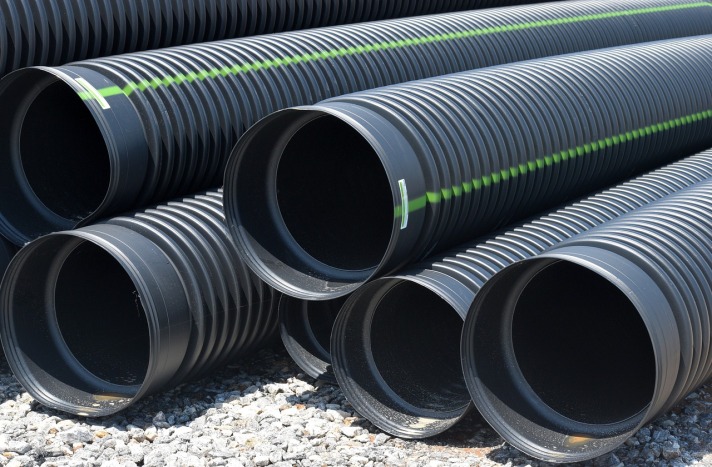
Nationwide, recent supply of PVC has been tight. Many plastic pipe manufacturing facilities are located in the southeast, which meant many operations were temporarily closed in advance of Hurricane Irma. “We figure from a national perspective there were probably 10 plastic pipe plants in that area that saw down time,” says Dersham. “Curtailing production for just three to five days may have taken five million pounds out of production.”
In the aftermath of Harvey, two Houston-area PVC resin or ethylene manufacturers evoked the Force Majeure clause saying they might not be able to supply their existing contractual customers. “Calling Force Majeure can create an immediate perception of tight supply or rising prices,” Dersham says. “It put everyone on high alert.” Large incoming order volume stretched out delivery lead times from some pipe manufacturers. “Some customers, with orders committed with our competition, have complained of waiting for up to six weeks to get product that would usually ship within two or three days.”
So far, Atkore has received an uninterrupted supply of PVC resin and all seven facilities are operating at full capacity. And to be clear, it’s highly unlikely that any Oregon-made PVC pipe will end up in the rebuilding efforts in Houston or Puerto Rico. “Freight costs are huge for PVC pipe. Usually it is cost effective to ship a maximum of just 500 or 600 miles,” Dersham says. Larger market forces, however, have put a pinch on supply and demand all the way out here in the Northwest.
Rebecca Taylor, corporate communications director at Roseburg Lumber and BRING board member, says the lumber industry is in a similar situation. “There are no real concerns about a shortage or lack of availability of wood products,” she says. “However, a number of factors will put upward pressure on the cost of those products in the market. Housing starts are reasonably healthy right now, so order sheets are already pretty full at manufacturing facilities like ours. Forest fires in the western U.S. are affecting the flow of logs to western manufacturing facilities.” (However, most lumber companies keep an inventory of logs on hand, so they aren’t desperate for logs just yet.)
“The market may see additional impacts in a couple of months, once the clean-up phase [from the hurricanes] is done and reconstruction begins,” she continues. “That’s when you’ll see greater demand for lumber and structural panels, both of which we supply. I’m not sure how it will affect Roseburg, but our team expects higher demand and increased prices for building materials to stretch well into the fourth quarter of the year, when demand typically ebbs and slows.”
Again, it’s unlikely that much Northwest lumber will end up in the southern United States. The region has plenty of plywood manufacturers there, and builders are much more likely to source material from them. But, Taylor says, “We are, to a certain degree, affected by the increase in prices for plywood across the market. A key indicator, ½-inch Western plywood, has gone up $27 per thousand square feet. Southern pine… has gone up $50 per thousand square feet.”
There are also the northern California wildfires to consider when watching the cost and availability of building materials. Over 5,000 homes have already been lost, along with many more offices and stores. California companies may be more likely to source materials from Oregon given its proximity.
Disasters highlight importance of reuse
“The recent spate of natural disasters drives homes how important it is to conserve resources and use them wisely,” says BRING executive director Carolyn Stein. “There’s going to be a huge boom in the construction industry as people rebuild their homes and lives.”
Now more than ever, it’s easy to see how all materials – even those that have been gently used – have tremendous value. When things like lumber, piping, windows and doors, fixtures and wiring are in short supply, or are suddenly very expensive, homeowners and home builders must utilize every resource that’s available to them. “By shopping at BRING and reusing building materials, you’re putting less pressure on resources overall,” Stein says. “It’s affordable and practical. It makes sense that we would use these things, particularly now, when concerns about scarcity and pricing are so real.”
There’s another big reason reuse makes so much sense. While no expert will say that climate change caused Hurricane Harvey or Irma, or started the wildfires in Oregon or California, most agree that it made them worse. Warmer oceans and rising seas make hurricanes bigger and more dangerous. Things like drought and insect damage make trees more flammable and fires burn hotter. Our only hope to stop natural disasters from getting bigger and more frequent is to stop or reverse the planet’s warming. Reuse (as well as reducing consumption, recycling and composting) are a very important part of that.
Now is a great time to make a change in your buying habits – in part because you may have to, and in part because this year’s catastrophes have made the dangers of climate change seem even more dire. “People need to get into the habit of looking for used materials before they pop over to a store to buy something new,” says Stein. “As with anything, it becomes more of a habit if you do it frequently. We want people to change their behavior and see used materials as not only valuable, but also better for the climate and their pocketbook.”


 Planning is underway for the 10th anniversary of the annual BRING Home and Garden Tour. We are on the lookout for leading-edge new homes, remodels, gardens, and urban farms that demonstrate sustainability. We’re especially interested in projects with the following features, whether designed and built by professionals or the do-it-yourselfer:
Planning is underway for the 10th anniversary of the annual BRING Home and Garden Tour. We are on the lookout for leading-edge new homes, remodels, gardens, and urban farms that demonstrate sustainability. We’re especially interested in projects with the following features, whether designed and built by professionals or the do-it-yourselfer: Christmas, Hanukah and the other December holidays are a time for giving and generosity. But when we give physical gifts, they come with a price beyond what we pay for them. The amount Americans put in the trash goes up by about 25 million tons in November and December. That’s a 25 percent increase over the rest of the year.
Christmas, Hanukah and the other December holidays are a time for giving and generosity. But when we give physical gifts, they come with a price beyond what we pay for them. The amount Americans put in the trash goes up by about 25 million tons in November and December. That’s a 25 percent increase over the rest of the year.
 Go electronic (or homemade) with your greeting cards
Go electronic (or homemade) with your greeting cards 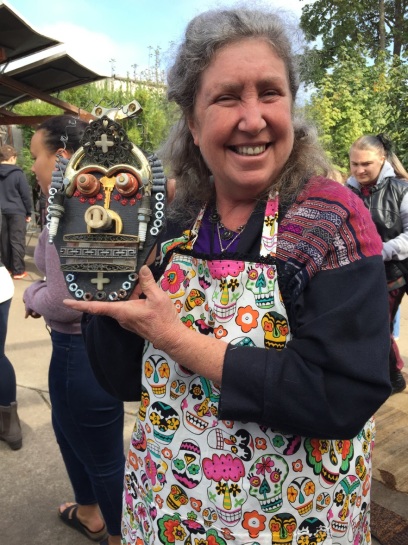 The new year is bringing a new direction for BRING. For the past 12 months we’ve been asking our stakeholders what they appreciate about BRING and how we can expand our many programs. The answers we got – and if they came from you, thank you! – are helping us chart an exciting new course.
The new year is bringing a new direction for BRING. For the past 12 months we’ve been asking our stakeholders what they appreciate about BRING and how we can expand our many programs. The answers we got – and if they came from you, thank you! – are helping us chart an exciting new course. We live in a time when it’s hard to feel like you can make a difference. At BRING, we believe small actions taken at the local level make the biggest difference of all. When you reduce, reuse, recycle, and compost, you’re part of the solution to reducing the impacts of climate change. And when you make a contribution to BRING, you’re part of a larger network that keeps our educational and action-oriented programs going.
We live in a time when it’s hard to feel like you can make a difference. At BRING, we believe small actions taken at the local level make the biggest difference of all. When you reduce, reuse, recycle, and compost, you’re part of the solution to reducing the impacts of climate change. And when you make a contribution to BRING, you’re part of a larger network that keeps our educational and action-oriented programs going. 
 Since BRING launched the C+D pilot earlier this year, we have worked with a number of construction projects in Eugene to divert reusable C+D materials from the waste stream. Here is a snapshot of the materials we have saved from the landfill:
Since BRING launched the C+D pilot earlier this year, we have worked with a number of construction projects in Eugene to divert reusable C+D materials from the waste stream. Here is a snapshot of the materials we have saved from the landfill: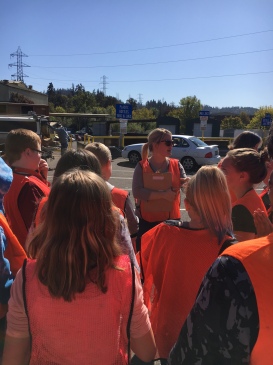 Educating community members about where our waste goes and why it’s so important to generate less of it has always been an important part of BRING’s work. That’s why we offer a range of
Educating community members about where our waste goes and why it’s so important to generate less of it has always been an important part of BRING’s work. That’s why we offer a range of 
 Before she takes the group to the containers holding electronics, wood and other materials for recycling, Shelton leads them to the trash pit. It’s a warm day, which makes the smell worse, something the students don’t hesitate to point out. A few noses are quickly tucked inside of shirts, and there are lots of exclamations of “Ewww!” and “Gross!”
Before she takes the group to the containers holding electronics, wood and other materials for recycling, Shelton leads them to the trash pit. It’s a warm day, which makes the smell worse, something the students don’t hesitate to point out. A few noses are quickly tucked inside of shirts, and there are lots of exclamations of “Ewww!” and “Gross!” The tour provides a good opportunity to educate the students on how to be better curbside recyclers. Glass needs to be separated from other materials because broken shards can injure workers or get into other recycling streams. The only type of plastic containers that should go in are bottles, tubs and jugs.
The tour provides a good opportunity to educate the students on how to be better curbside recyclers. Glass needs to be separated from other materials because broken shards can injure workers or get into other recycling streams. The only type of plastic containers that should go in are bottles, tubs and jugs. Imagine never having to go to the gas station again, cutting your car maintenance bills in half, and enjoying the quietest ride on the road. Impossible? Nope, that’s what electric vehicle (EV) ownership is all about and it’s more accessible than ever! Oh, and did we mention zero carbon emissions?
Imagine never having to go to the gas station again, cutting your car maintenance bills in half, and enjoying the quietest ride on the road. Impossible? Nope, that’s what electric vehicle (EV) ownership is all about and it’s more accessible than ever! Oh, and did we mention zero carbon emissions?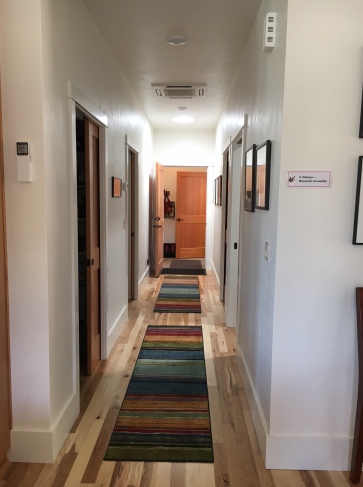
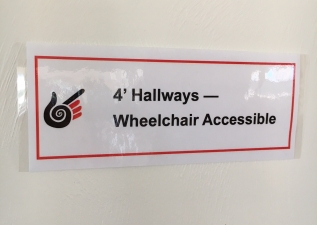 live in homes crafted with materials that will not leach chemicals. Older folks are less able to perform maintenance tasks on their homes. Homes built with quality, long-lasting materials will require less labor. Homes with universal design features don’t need few resource-consuming (and expensive) modifications such as wheelchair ramps or lifts.
live in homes crafted with materials that will not leach chemicals. Older folks are less able to perform maintenance tasks on their homes. Homes built with quality, long-lasting materials will require less labor. Homes with universal design features don’t need few resource-consuming (and expensive) modifications such as wheelchair ramps or lifts. local nonprofits are bringing sustainable housing to low-income people. Because eco-friendly materials and systems are often more expensive than their conventional counterparts, we typically think of green housing as only being available to people with resources. But working families, veterans, people with disabilities and homeless youth also deserve to live in high-quality, healthy homes that tread lightly on the earth. It’s exciting to see this happening in the Eugene-Springfield area.
local nonprofits are bringing sustainable housing to low-income people. Because eco-friendly materials and systems are often more expensive than their conventional counterparts, we typically think of green housing as only being available to people with resources. But working families, veterans, people with disabilities and homeless youth also deserve to live in high-quality, healthy homes that tread lightly on the earth. It’s exciting to see this happening in the Eugene-Springfield area.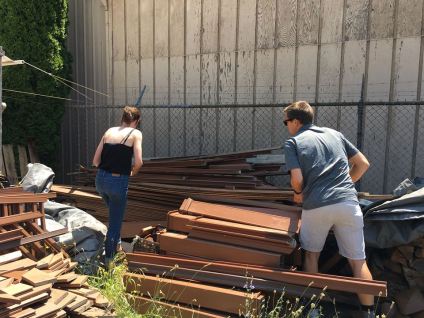 policy, planning and management master’s student and member of the three-person leadership team that also includes architecture student Samantha Freson. “At missions they can only take brief showers. A bathtub symbolizes relaxation and safety.”
policy, planning and management master’s student and member of the three-person leadership team that also includes architecture student Samantha Freson. “At missions they can only take brief showers. A bathtub symbolizes relaxation and safety.”